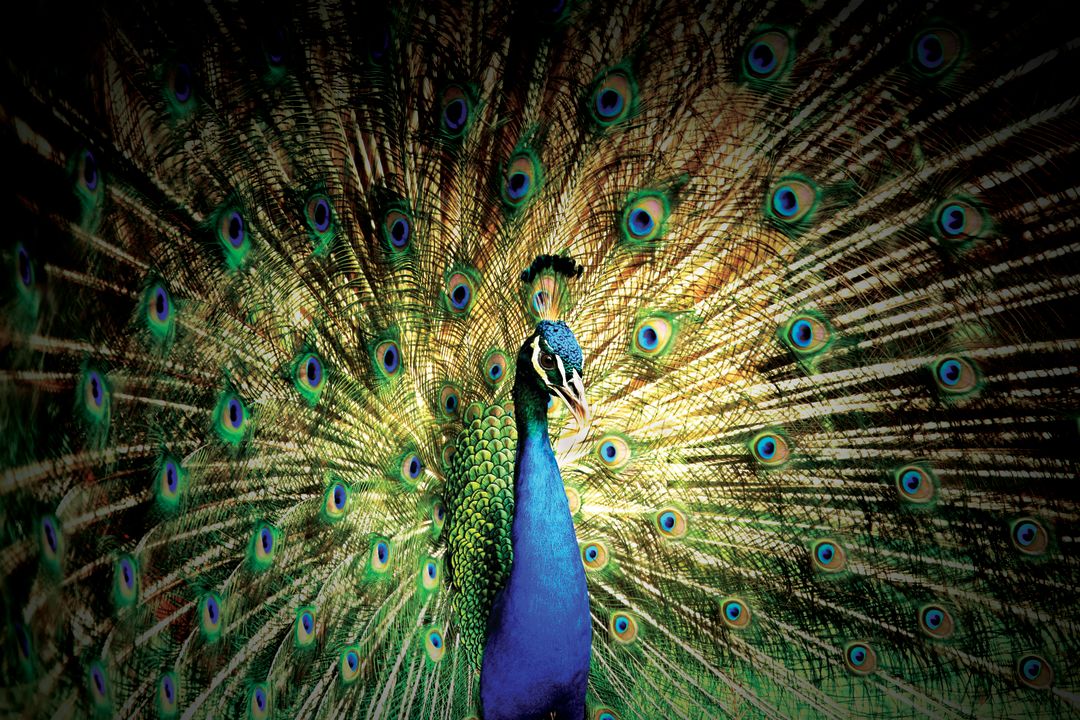Yes, Those Longboat Key Peacocks are Beautiful—Until You Have to Live With Them

Peacocks, like this one in all his feathered glory, have been a familiar—but often unwelcome—sight on the streets of Longbeach Village for more than 50 years.
Longboat Key’s peacocks are going the way of the dodo—if the dodo had been humanely trapped and relocated to a bird sanctuary, that is.
For the past 60 or so years, a party (flocks of peafowl are called “parties”) of these regal birds have called the Longbeach Village neighborhood on the island’s northern tip home. Residents say the birds will eat just about anything tossed out of car windows to them, including Doritos and leftover spaghetti from nearby Mar Vista restaurant.
“I knew the birds were beautiful. Now I know they have advanced palates,” quips Mar Vista owner Ed Chiles.
With the males’ iridescent blue chests and signature fanned tail feather displays, the peafowl (males are peacocks, females peahens) are the most stunning of living lawn ornaments. They were first kept by maharajas in India as symbols of grace and wealth. In the Middle Ages, European royalty both raised them and ate them, and early Christians used them in art as symbols of immortality.
It was in the 1950s or ’60s, according to local lore, that a Longboat couple received a mating pair as a wedding gift. Somehow those first two got loose—perhaps released as islanders fled an impending hurricane—and finding Longboat just as lovely as everyone else does, they decided to stay and breed. Estimated last year at more than 50, their descendants keep to a three-block radius north of Broadway Street. Their sheer number in such a small area has brought about their demise.
For all their beauty, peafowl make for terrible neighbors, residents say. They roost where they want, leave behind a mess, and their loud “Wah-WAH!” calls begin at dawn and go on all day. They also attract tourists, who jam the narrow streets to feed and photograph the birds.
The Town of Longboat Key in January approved spending $25,000 to have the birds, with the exception of 12 males, trapped and removed. Palmetto’s Nuisance Animal Removal was contracted; four months into the project, lead trapper Christy Norris had caught 26 birds—19 males, seven females—according to Mark Richardson of Longboat’s Public Works Department.
“We’ve been catching the young males,” said Richardson. “The big males with the long tail feathers are too smart to go into the trap.”
The trap is a netted enclosure about the size of an above-ground swimming pool on an empty lot on Russell Street. Norris coaxes them inside, offering them blueberries from her hand. When they enter, she pulls down the door behind them, grabs them by their feet and transports them in cages to Palmetto’s Birds of Paradise Sanctuary and Rescue.
“They have to be caged for 30 to 60 days [to habituate to a new location]; otherwise they would come right back here,” Norris said. “Birds of Paradise has enough space for them. They are not just put in a dog cage.”
“It’s truly a nightmare,” said one 28-year village resident—who asked not to be named—as she watched Norris try to lure a male into the trap this spring. “I have a $55,000 Mercedes, and they scratched the hood. The tourists think they are in a petting zoo. If a bird is on your porch, they will walk right up your stairs.”
“It’s pitted neighbor against neighbor,” said a 36-year resident, also asking that she not be named. “We’ve learned not to talk about it with each other.”
Longboat officials have tried to reduce the population before, but attempts failed when the birds grew wise to the methods. This time, Norris is authorized to tranquilize the birds if needed.
But for now, she’s sticking with the trap. As neighbors watched, Norris knelt inside the netted enclosure, holding out some berries. A vivid-blue male the size of a turkey looked interested in those berries, carefully zigzagging through the grass towards her.
Across the lot, a half dozen other peafowl stood in the shade of a palm tree, looking on as though to see what would happen. Norris backed deeper into the trap; the male slowly approached. Then he got to the doorway and peered in—one more step and he’d be trapped. Instead, he pivoted and headed to freedom.
Norris sighed. “Wah-WAH!” cried a nearby peacock.



